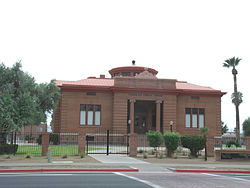Phoenix Carnegie Library and Library Park
|
Phoenix Carnegie Library and Library Park
|
|
 |
|
| Location | 1101 W. Washington St., Phoenix, Arizona |
|---|---|
| Coordinates | 33°26′51″N 112°5′10″W / 33.44750°N 112.08611°WCoordinates: 33°26′51″N 112°5′10″W / 33.44750°N 112.08611°W |
| Area | 4 acres (1.6 ha) |
| Built | 1908 |
| Architect | Millard & Creighton; William R. Norton; Reeves & Baillie |
| NRHP Reference # | 74000456 |
| Added to NRHP | November 19, 1974 |
The Phoenix Carnegie Library and Library Park , now known as the Carnegie Center, is a historic site in Phoenix, Arizona. Completed in 1908, it was listed on the National Register of Historic Places in 1974.
The first Phoenix public library opened in the spring of 1898 thanks to the efforts of the Friday Club, whose members collected books and secured two rooms on the second floor of the Fleming Block, one of the largest office buildings in downtown Phoenix. This venture was so well received that the following spring, the Phoenix Library Association was formed and the expanded library moved into a room in Phoenix City Hall which had been vacated by the legislative assembly, having moved to the new capitol building made the rooms available for other purposes. The books of the library were now for the first time catalogued by the Dewey system.
The success of the library made necessary a more permanent and structured arrangement, and the Library Association consequently endeavored to transfer the project to the city. However, this could not be accomplished until March 1901 after an amendment to the territorial statutes. At this time, the Phoenix Public Library was established, with 1350 volumes.
Since 1899 the Library Association had been unsuccessfully attempting to secure a grant from Andrew Carnegie, and in December 1901 the Phoenix Woman's Club joined the campaign. Some progress was made in March 1902 when the city agreed to put up the required 10% of the anticipated $25,000 grant and to levy an annual tax of 5 mills on the dollar. In June, the city agreed to furnish the site if the grant was received.
Negotiations with Carnegie hit a snag when he saw the 1900 census report giving Phoenix a population of 5500, and decided that a grant of $15,000 would be sufficient. However, by the fall of 1903 a committee had gathered evidence to show that additions of land and population to Phoenix since 1900 had resulted in a population of 14,000. The committee also pointed out that the nearest public libraries were in Tucson and Prescott, leaving the entire Salt River Valley in need of this public service. Carnegie was convinced and agreed to the original sum of $25,000.
...
Wikipedia


